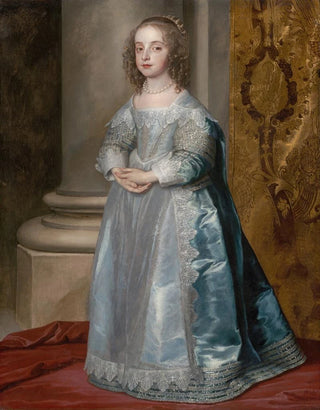Art print | Princess Mary, daughter of Charles I - Anthony van Dyck


View from behind

Frame (optional)
Princess Mary, daughter of Charles I - Antoine van Dyck – Captivating Introduction
The canvas "Princess Mary, daughter of Charles I" by Antoine van Dyck is an iconic work that embodies the very essence of royal portraiture in the 17th century. In this depiction, the delicacy of the subject and the artist's technical mastery combine to offer a fascinating glimpse into the English court. Mary Stuart, daughter of Charles I, is portrayed with a grace and dignity that transcend mere portraiture to become a true celebration of royalty. This painting, rich in detail and emotion, transports the viewer to an era where art served not only to immortalize historical figures but also to affirm their power and status.
Style and uniqueness of the work
Van Dyck's style is distinguished by his ability to capture the personality and spirit of his subjects. In "Princess Mary, daughter of Charles I," he uses a palette of soft colors and subtle play of light to enhance the beauty of the princess. The drapery of her dress, carefully rendered, testifies to impeccable technique, where each fold seems to tell a story. Mary's pose, slightly turned, and her contemplative gaze add a psychological dimension to the portrait, inviting the observer to ponder her inner thoughts. This painting, while respecting the conventions of official portraiture, stands out for its ability to humanize the royal figure, offering a striking intimacy that echoes the soul of her era.
The artist and his influence
Antoine van Dyck, born in Flanders, established himself as one of the greatest portraitists of his time. He was influenced by the masters of Flemish painting, while incorporating elements of Italian tradition, which allowed him to develop a unique style. His arrival at the English court, where he was appointed official painter to Charles I, marked a turning point in his career. Van Dyck not only redefined royal portraiture but also inspired many artists who followed him. His approach to portraiture, blending realism and idealization, left an indelible mark on art history, influencing generations of artists in their quest to capture

Matte finish

View from behind

Frame (optional)
Princess Mary, daughter of Charles I - Antoine van Dyck – Captivating Introduction
The canvas "Princess Mary, daughter of Charles I" by Antoine van Dyck is an iconic work that embodies the very essence of royal portraiture in the 17th century. In this depiction, the delicacy of the subject and the artist's technical mastery combine to offer a fascinating glimpse into the English court. Mary Stuart, daughter of Charles I, is portrayed with a grace and dignity that transcend mere portraiture to become a true celebration of royalty. This painting, rich in detail and emotion, transports the viewer to an era where art served not only to immortalize historical figures but also to affirm their power and status.
Style and uniqueness of the work
Van Dyck's style is distinguished by his ability to capture the personality and spirit of his subjects. In "Princess Mary, daughter of Charles I," he uses a palette of soft colors and subtle play of light to enhance the beauty of the princess. The drapery of her dress, carefully rendered, testifies to impeccable technique, where each fold seems to tell a story. Mary's pose, slightly turned, and her contemplative gaze add a psychological dimension to the portrait, inviting the observer to ponder her inner thoughts. This painting, while respecting the conventions of official portraiture, stands out for its ability to humanize the royal figure, offering a striking intimacy that echoes the soul of her era.
The artist and his influence
Antoine van Dyck, born in Flanders, established himself as one of the greatest portraitists of his time. He was influenced by the masters of Flemish painting, while incorporating elements of Italian tradition, which allowed him to develop a unique style. His arrival at the English court, where he was appointed official painter to Charles I, marked a turning point in his career. Van Dyck not only redefined royal portraiture but also inspired many artists who followed him. His approach to portraiture, blending realism and idealization, left an indelible mark on art history, influencing generations of artists in their quest to capture






